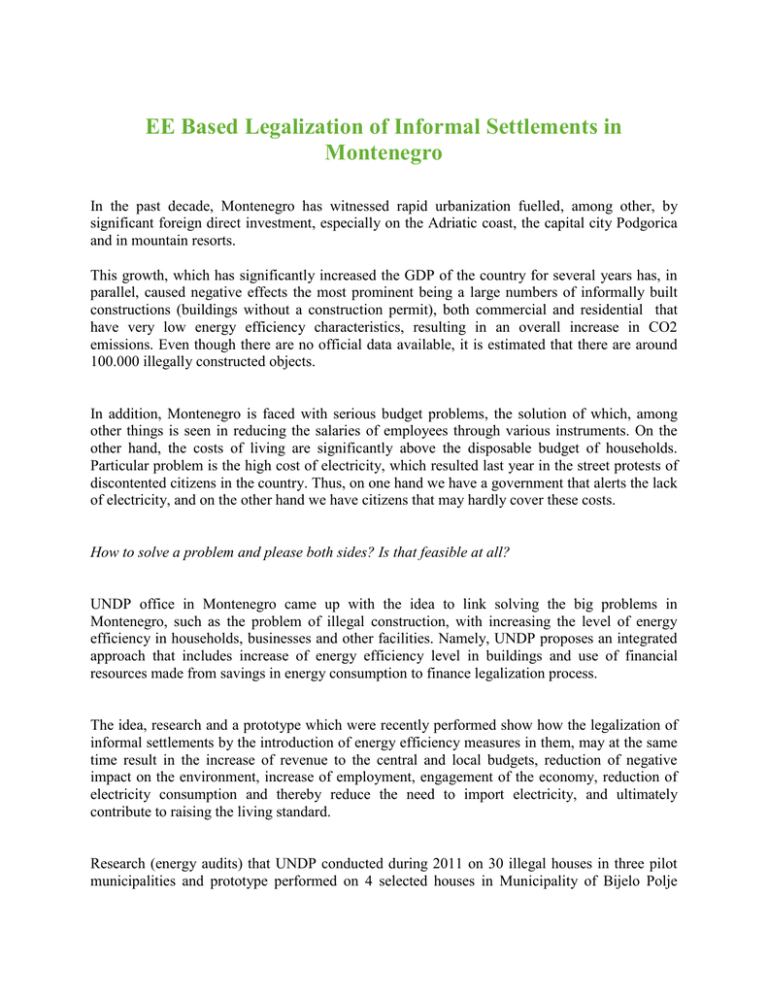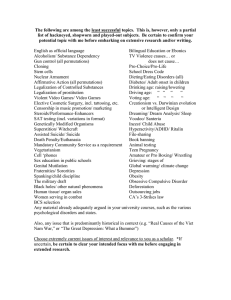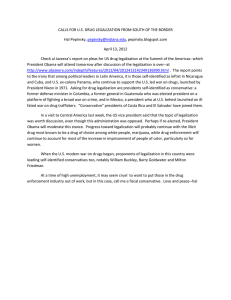EE Based Legalization of Informal Settlements in Montenegro
advertisement

EE Based Legalization of Informal Settlements in Montenegro In the past decade, Montenegro has witnessed rapid urbanization fuelled, among other, by significant foreign direct investment, especially on the Adriatic coast, the capital city Podgorica and in mountain resorts. This growth, which has significantly increased the GDP of the country for several years has, in parallel, caused negative effects the most prominent being a large numbers of informally built constructions (buildings without a construction permit), both commercial and residential that have very low energy efficiency characteristics, resulting in an overall increase in CO2 emissions. Even though there are no official data available, it is estimated that there are around 100.000 illegally constructed objects. In addition, Montenegro is faced with serious budget problems, the solution of which, among other things is seen in reducing the salaries of employees through various instruments. On the other hand, the costs of living are significantly above the disposable budget of households. Particular problem is the high cost of electricity, which resulted last year in the street protests of discontented citizens in the country. Thus, on one hand we have a government that alerts the lack of electricity, and on the other hand we have citizens that may hardly cover these costs. How to solve a problem and please both sides? Is that feasible at all? UNDP office in Montenegro came up with the idea to link solving the big problems in Montenegro, such as the problem of illegal construction, with increasing the level of energy efficiency in households, businesses and other facilities. Namely, UNDP proposes an integrated approach that includes increase of energy efficiency level in buildings and use of financial resources made from savings in energy consumption to finance legalization process. The idea, research and a prototype which were recently performed show how the legalization of informal settlements by the introduction of energy efficiency measures in them, may at the same time result in the increase of revenue to the central and local budgets, reduction of negative impact on the environment, increase of employment, engagement of the economy, reduction of electricity consumption and thereby reduce the need to import electricity, and ultimately contribute to raising the living standard. Research (energy audits) that UNDP conducted during 2011 on 30 illegal houses in three pilot municipalities and prototype performed on 4 selected houses in Municipality of Bijelo Polje showed that significant savings in energy consumption could be realized. After revision and demonstration through the prototype, and the repeated reviews after reconstructions, the following conclusion was reached regarding the possibility for EE retrofitting in informal settlements: on average, a € 5,000 investment is needed for retrofit of a 100 m2 house, which creates annual energy savings of 63% on average (investment payoff around 6 years). Existence of a large number of informal buildings, primarily residential facilities, highlights the urgent need for organized approach to resolving the problem of regularization of such buildings and verifying achieved level of their static and seismic protection. The Government of Montenegro has adopted a National Formalisation Program (NFP) and the Action Plan for its implementation. The new Regularization Law has been adopted by the Government of Montenegro and its adoption by the Parliament is pending. Among other, the law envisages the possibility to pay legalization costs for a period of min 20 years, and the possibility for local governments to apply different modalities of legalization. UNDP approach to the legalization problem National Formalization Program will result in new policies, regulation and significant investment to transform illegal housing stock into regularized legal buildings. However, if implemented as designed at the beginning, NFP would not bring in energy efficiency improvements in individual houses, which are now characterized by poor thermal performance, high energy use and offer major opportunities for cost-effective GHG emission reduction. In order to address this problem, UNDP designed the National Formalization Program in such manner that it would incorporate mandatory requirements and financial support package for energy efficiency improvements as outlined in the following section. The formalization of Montenegro’s informal settlements represents a unique opportunity to not only insert EE considerations into regulation of this building stock (for the first time ever), but also to integrate informal neighbourhoods and settlements into municipal governments’ spatial planning in order to address urban-system GHG mitigation opportunities inside town areas. UNDP research and prototype In the beginning of 2011 Ministry of Sustainable Development and Tourism of Montenegro and UNDP agreed on joint implementation of three new pilot projects which deal with problem of transformation of informal settlements to formal. This is related to three municipalities: Zabljak, Bijelo Polje and Bar. Purpose of the energy audits was to determine a baseline for consumption and potential savings, giving the most basic renovation/retrofit measures. Every energy audit consisted of basic information about the existing object, its current use, dimensions, number of inhabitants, heating periods during the day and the whole year, local climate characteristics etc. The following most cost effective and most frequent basic EE measures have been suggested: appropriate isolation of external walls; replacement of windows/doors; roofs isolation, floors isolation. After review of the conducted audits, the general conclusion reached was that on average reconstruction (retrofitting) of illegal households in Montenegro could reach 59% of electricity consumption savings, which leads to the return period shorter than 7 years. In order to test the above estimations through demonstration, during 2012 UNDP team performed a prototype i.e. reconstruction of 4 illegal household facilities in Bijelo Polje, measuring energy consumption before and after reconstruction. M1 12.8oC M3 7.7 oC M2 2.5 oC M4 6.7 oC Photo 1: One of 4 reconstructed houses in the informal settlement Resnik/Resovo in Bijelo Polje, before and after reconstruction with EE measures and results of thermal camera imaging. Post reconstruction (retrofitting) audits showed even better results in relation to preliminary controls. Measurements conducted showed that energy savings vary from 50% to 82% (65% on average), which means the period of return on investment from 5 to 6.3 years. This prototype showed that even implementing additional and relatively expensive measures like installation of new central heating system, which is not considered as a measure which will improve EE performance, but will in general raise a living comfort, is economically justified. In that case, return on investment would be, in total, 7 years. Table 1: Basic prototype results Savings in delivered energy Net savings Total investment (EE measures) Return on investment 34.763 kWh/god. 767 €/year 4,698 € 6,4 years Source: UNDP estimate, prototype Resnik – Resovo, Bijelo Polje Energy efficiency in the service of formalization The presented audits were conducted with the aim to check the concept developed by the joint team of the Ministry of Sustainable Development and Tourism and UNDP. The results obtained from energy audits and tested later through prototype, confirmed that the approach to informal settlements formalization in Montenegro which implies implementation of EE measures on illegal buildings is justified and can bring considerable economics benefits both to the state and the economy, and to population and their way and quality of life. Environmental impact which is reflected in the greenhouse gases effects reduction is not negligible either. Economic effects Methodology used for calculation and analysis of EE measures implementation in the formalization process is based on: putting forward a hypothesis, audit and data processing, use of the experiment in the economy, modelling and verification. The author further dwells on general methodological procedures in economy: analytic, synthetic, historical method, macroeconomic and microeconomic analysis method. After putting forward the hypothesis: Can implementation of EE measures on illegally constructed objects ensure financial resources necessary for formalization itself?, by means of the above mentioned methods the hypothesis is tested and approved. In order to test the hypothesis, an investigation (energy efficiency audits of illegally constructed buildings) was performed, as well as an experiment (prototype). Data obtained from the experiment were calculated and average values were determined (for a 100 m2 building) and by linear extrapolation they were transferred to the level of entire economy and country (the assumption on existence of 100 000 illegal buildings in Montenegro was used). The following parameters were taken into account: Initial energy consumption in the building; Amount of investment needed for retrofitting; Savings in energy consumption; Reduction of CO2 emissions; Time period for return on investment; Number of employees engaged on retrofitting; VAT produced by the given investment (activity); Amount of expenses for legalization. The above data were calculated for four houses that were reconstructed, average values were determined, and transformed for the level of a 100m2 object, as reference points, and then estimated for the level of entire economy. Impact for the following categories was determined: GDP, Employment, Level of investments (activity) in the construction sector, Amount of revenues from VAT, Amount of revenues from legalization, Reduction of gross energy consumption in Montenegro, Energy import/export. The basic results can be found below. Experiment results –100 m2house Energy audits of 34 objects (municipalities Bar, Bijelo Polje and Žabljak) showed that average energy consumption (electric energy, wood, and coal) on average amount to 57.416 KWh annually, i.e. 63.619 KWh annually for a 100 m2 household. Implementation of EE measures implies: replacement of windows and doors, roof isolation, isolation of external walls, where replacement of floors is needed. The average investment needed for implementation of the stated measures is 4,698 Euro, i.e. 5,000 Euro for a 100 m2 building. In addition, an investment of 5.000 Euro creates 850 Euro of VAT. Savings in energy consumption that can be achieved through the above measures amount on average to 34.760 KWh annually or 767 Euro, i.e. for a 100 m2 household to 37.900 KWh annually or 830 Euro. Thus, expressed in percentages the average electrical energy saving is 63%. According to the records kept daily through the measurement book and reports of the supervision body, 5 workers were engaged on reconstruction every day (construction company); one employee was engaged for supervision works, and in the initial phase one employee for development of project documents and one for management of the entire process. For all this, engagement of seven persons per object/building is needed. Based on the obtained entry data, it is easy to calculate the time period of return on investment into retrofitting, and it is on average 6,12 years. In addition, EE measures can lead to reduction of CO2 emissions of 1.000 kg annually per object. The presented data represent inputs for further analysis into effects of EE measures implemented on illegally constructed objects in Montenegro based on macro-economic indicators, and for determining the possibility to use financial means made through savings in energy consumption on micro and macro level, for financing the legalization process. If the obtained data are estimated for the entire economy, taking into account the assumption that the number of illegally constructed objects in Montenegro is 100.000 the following macroeconomic implications are obtained: ***Note: with regard to the size of the objects, the assumption is that it is not realistic to expect that all objects are reconstructed in one year. We start from the assumption that this is a longstanding process, and that 10.000 objects can be reconstructed annually. This assumption was taken into account when calculating the annual data. Level of investments – retrofit of 100.000 buildings would create around 470 million Euro direct investments in the construction sector and provide work for the entire construction sector in Montenegrin economy. Also, in an indirect manner this level of investment would stimulate increase of activities in other sectors and economic branches. At the annual level 47 million Euro of direct investments is expected, which is around 14% in relation to the current level of construction work in Montenegro; Amount of revenues from VAT – direct effect of retrofit would reflect in an increase of revenues from VAT in the total amount of around 80 million Euro, i.e. 8 million € at the annual level, which would increase budget revenues from VAT by 2.5% at the annual level in the following 10 years; Employment – when calculating the level of employment we took into account two scenarios. One is based on the results of the prototype and its extrapolation on the total number of objects. The second scenario starts from the fact which is the result of numerous investigations that tried to calculate the number of new jobs created by investments into energy efficiency, according to which an investment of one million dollars creates 10 jobs. The total number of jobs created by reconstruction of 100.000 objects, according to the first scenario, is assessed at around 60.000, which is significantly more in relation to the total number of unemployed in Montenegro, and would even mean the need to import work force. However, precise estimation of the number of employees cannot be made without information related to the dynamics of reconstructions, number of objects at the annual level, number of companies performing reconstructions, project development, energy audits, supervision and the like. Due to lack of adequate information, we used data from the second scenario, and according to it the total number of new jobs that can be created by the above legalization process amounts to 6.200 which reduces the number of unemployed by 13%; Reduction of energy consumption in Montenegro – retrofit of 100.000 objects would lead to reduction in the total energy consumption by around 3.476 GWH for the period of 10 years, i.e. 347 GWh annually. This would have enormous positive effects on the already highly loaded energy network in Montenegro, i.e. it would reduce by 27% import of energy annually, and after less than 4 years it would entirely eliminate the need to import electric energy and create space for export of energy in the following years. In addition, observed in the period of 20 years, which is the period of repayment of compensation for legalization, two scenarios were calculated when electric energy consumption is concerned. The first, basic scenario envisages energy consumption which is unchanged in relation to the present moment. The second scenario calculates consumption taking into account measures for increasing energy efficiency. Moreover, since the price of electric energy is expected to rise in the following period, a calculation (trend) of electric energy price was done for both scenarios in the period of 20 years. The annual growth rate of 2% was used in the calculation.1 The following results were obtained: according to the basic scenario total consumption of an average 100 m2 household in a period of 20 years will amount to 1,280 MWh, i.e. 46.359 Euro. On the other side, scenario that envisages EE measures implementation shows that the total consumption of an average 100 m2 household in the period of 20 years will amount to 500 MWh, i.e. 18.223 Euro, which is 2,5 times less in relation to the basic scenario; 1 GDP – increased activity in the construction sector would have direct effect on the increase of GDP of 1,5% annually, in the following 10 years; Amount of revenues from legalization – the amount of fee for legalization varies depending on a number of factors, such as: town in which the object is located, construction zone, urban or rural environment and the like. In the settlement ResnikRasovo, where the experiment was conducted, the legalization fee is 20 Euro per square meter. However, in Podgorica and the seaside towns it is considerably higher, while in some of the northern municipalities it is even lower. That is why in our analysis we started from the assumption that legalization cost is 50 Euro per square meter, and in compliance with the provisions of the new Law on Regularization of Illegal Objects, it is envisaged that legalization cost can be paid in the long time period (min 20 years), in monthly instalments. Taking into account all the above, we come to the conclusion that local self-governments in Montenegro can collect a total of 500 million Euro of revenues from legalization in the period of 20 years, i.e. 25 million Euro annually or slightly over 2 million Euro at the monthly level, which is considerable inflow for small municipal budgets. This would ensure sustainability of local budgets in the long run. Increase of revenues from property tax - due to lack of an inventory of illegal objects which would provide information important for defining property tax rate (location, number of floors, floor area, use and the like) it is not possible to determine the amount Source: Annual Energy Outlook, with projection to 2035, U.S. Energy Information Administration (EIA ), June 2012 of property tax that would be collected; however it is evident that 100.000 objects that make one half of the total number of registered households in Montenegro can generate considerable revenues for Montenegrin budget. Financial mechanisms For implementation of the presented model of legalization, first of all the answer to the following question must be given: In what manner can funds for reconstruction of objects be secured? The following financial mechanism can be recognized: Commercial bank loans – on Montenegrin market there are loan arrangements for households and companies for investment into energy efficiency. Loans are given for the period of 7 years at the annual interest rate of 7%. This is the most unfavourable form of financial mechanism, however, the expected level of savings would be sufficient to cover the amount of monthly instalment for the loan. Loan of international financial institution (EIB; EBRD and the like) – the given mechanism implies organization of a state programme, similar to programmes implemented by the Government of Montenegro so far (such as Program 1000+ for example), which foresees the state taking loan from an international financial institution according to favourable credit conditions (low interest rate, grace period, adequate repayment term), which would be offered to owners of illegal objects through a network of commercial banks. Savings in energy consumption would be sufficient for covering the loan instalment and costs for legalization. Entry of the ESCO company – ESCO - Energy Service Companies do business in the world acting both as investors and contractors of works for energy efficiency improvement. These companies perform energy audits, invest financial resources in reconstructions-retrofits and do reconstruction itself, perform control energy audits, and monitoring of consumption in the following several years; and they charge their services for a number of years (most frequently 8 to 10) from object owners at the monthly level, in the amount of savings made in energy consumption (or up to 80% of savings made). Loans taken from the republican Investment-Development Fund – this option is similar to the option of loan taking, where the municipality/state could act as an ESCO company, which performs works, and collects its claims from savings made. For this option the existing capacities can be used (eg. Agency for Construction of Podgorica, and the like) which would gradually be increased and strengthened. The approach to energy efficiency measures implementation in the legalization process is shown in table below, taking into account one of the possible scenarios, for an illegal 100m2 object. Household size Monthly expenses for energy Savings Legalization cost (50€ per m2) Reconstruction cost (i.r. of 4.5% for a loan of 5.000 €) 100 m2 110 € 63% 5000 € 7600 € Cost for energy Legalization cost for 20 years Retrofitting cost (20 years) Total 47.30 € 20.80 € After retrofitting Monthly 32.00 € 99.8 € The calculation shows that after reconstruction every household applying for legalization will have reduced expenses in relation to what it pays for energy, with the expenses now including legalization, energy consumption and reconstruction cost. This means that even with a smaller amount of money, now they will have a legal object, energy efficient, more comfortable and safer for living. Conclusion This idea shows potential for use of energy efficiency as an incentive to owners of illegal objects to start the process of their formalization. The first testing of the idea was done by UNDP, by means of the prototype. It was proved that the idea is based on sound grounds and that there is great potential for its successful implementation. However, the central and local authorities are at the helm. Successful implementation is possible only if there is ownership of the idea and the entire approach by municipalities themselves, with the support from the central level of decision making. UNDP office has the capacities and mechanisms for providing technical support to municipalities and the competent ministry in the implementation of the presented model.



